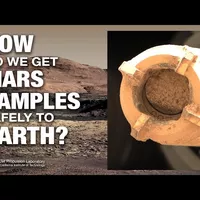How to Bring Mars Sample Tubes Safely to Earth (Mars News Report)
- The Perseverance Rover
is filling up tubes just like this
with rocky material from Mars.
And it's my job to protect them.
What kind of testing are we doing now
to make sure that they survive their journey back to earth?
Let's take a look.
(inspiring music)
- We are close to the base of a nearly 90 foot drop tower
here at NASA's Jet Propulsion Laboratory.
Places like this are designed
to help test out NASA's most ambitious campaign to date,
Mars Sample Return.
I'm Raquel Villanueva here with Aaron Yazzie.
He's in charge of keeping the sample tube safe
on their journey home.
So Aaron, what's the plan for Mars Sample Return?
- [Aaron] Mars Sample Return is the next leg,
in us being able to bring back
rocky samples from Mars to Earth
so that we can study them here
and look for signs of ancient life.
- [Raquel] What kind of testing is being done here at JPL
to prepare the sample tubes for their journey back to earth?
- [Aaron] The sample tubes have already gone through
a lot of testing to date,
but we're gonna continue testing
to make sure that they can survive
every leg of this mission.
Some of them involved mimicking Mars' environment.
Practice robotic handling of the tubes,
making sure that they can survive each of those steps.
The launch environment, the landing environment.
- [Raquel] Speaking of final descent back to earth
that's what the engineers are working on behind us.
Can you tell us a little bit more about those tests?
- The tower behind me
is actually able to mimic the event
from when the canister holding the sample tubes
will land back on earth.
One of the designs that we're currently testing out
is what kind of crushable material
we might want to use inside of that assembly.
So this right here
is actually a piece of titanium crushable
that we're gonna use with this mass simulator
to see how best to cradle and protect these tubes
when they land back on earth.
- What is being done to ensure
that this is a successful campaign?
- We are currently partnering with agencies
across the US and around the world,
the most predominant one being the European Space Agency.
We're actually working on building a hundred more test tubes
that we can distribute to all these teams,
so they can do all their testing and ensure
that everything will work like they designed it to.
- What are you most excited about
when it comes to Mars Sample Return?
- I am really excited about all the information
that these little rock samples hold inside them,
and especially the exciting probability
that we could find ancient life.
For me personally,
I come from an area in the US that looks like Mars.
The Navajo Nation is a rocky desert landscape
and it really reminds me how similar rocky planets
in our solar system can be.
- It's a very cool perspective to bring with you.
Thank you for your time, Aaron.
- Thank you.
- And NASA is sending your name to Mars.
So if you'd like to get a boarding pass
like Aaron has right here,
please follow the link below.
And to keep up with the latest updates
follow @nasajpl and @nasamars.
Or take a deeper dive
on the mission websites at mars.nasa.gov
(inspiring music intensifies then fades)

